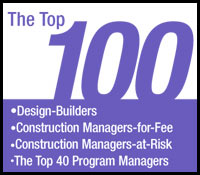
|
Construction management at-risk often is the stepchild of alternate project delivery methods. Some see CM at-risk as simply general contracting with an added level of risk-shifting by the owner. Some jokingly compare it to general contracting "while wearing a tie."
But the nature of being a major general contractor has changed, just as the demands of clients have. "We as an industry have changed over the last 10 years from a blue collar business to a white collar business," says John Fish, CEO of Suffolk Construction. He says large general contractors are doing less self-perform and are emphasizing more management skills and information technology to cope with increasingly complex and time-sensitive schedules.
这一趋势有一个有趣的副作用。“我have taken a look at some of the resumés weve received recently, and many of them are coming from top institutions of higher learning," Fish says.
 |
With the popping of the dot-com bubble a few years ago, students now are taking a new look at construction management. "These kids arent just looking at Wall Street or biotech anymore. They see the projected shortages in the industry and theyre not stupid. They understand what this will mean for compensation and job security down the line and are beginning to see construction as a viable alternative career path again," Fish says.
Whatever the perceptions of CM at-risk, it has been enjoying major success, even in a sluggish market. Revenue for ENRs Top 100 CM At-Risk Firms rose 11.4% to a record $50.94 billion in 2003. Th figure tops the previous high-water mark in 2001 of $50.69 billion.
That success stems partly from some traditional CM at-risk markets continuing to boom through the overall construction downturn. "Schools continue to be strong, and the hospital/health-care industry is a big market for our members," says Bruce DAgostino, executive director of the Construction Management Association of America, McLean, Va. "Now, federal work is driving growth."
But some firms are finding success even in softer market sectors. "The residential market has been very strong for us in the last few years through the downturn in the commercial office market," says Peter Palazzo, vice president of HRH Construction. He says the firm is building 1,500 condominium units in White Plains, N.Y., north of New York City, in Westchester County.
Palazzo says CM-at-risk is the project delivery method of choice in New York City because financial institutions require the protection provided by a reputable CM firm. HRH continues to work for long-time clients there, such as the Trump Organization, but the rest of the client base in New York has changed. "We are seeing more small developers securing air rights above existing structures and putting together $14-million to $18-million projects," he says. "These small developers may end up as the big developers of the future."
|
RELATED LINKS |
| THE TOP 100: OVERVIEW |
| THE TOP 100 DESIGN-BUILDERS|STORY|LIST| |
| CONSTRUCTION MANAGERS-for-FEE|STORY|LIST| |
| CONSTRUCTION MANAGERS-at-RISK|STORY|LIST| |
| THE TOP 40 PROGRAM MANAGERS |
Not all is rosy for CM at-risk firms. "We are seeing increasing price pressure on our members," says DAgostino, including the growing use of reverse auctions in the process industry. "Its simply bid-shopping done electronically."
This concern about price-based selection over qualifications has led CMAA to redouble its effort on certification. "We are placing even more emphasis on professionalism in the CM ranks," says DAgostino. "We now have 458 people certified under the program, and 300 more in the pipeline." He contends that this will give owners a clearer choice in choosing quality CM providers.
For some practitioners, CM at-risk is seen as the doorway for some owners to get involved in alternate project delivery. "The decision to go with CM at-risk or design-build often is driven by the culture of the owner," says David Crawford, president of Sundt Construction, whose firm is heavily involved in both project delivery methods.
Crawford, who is this years chairman of the Design-Build Institute of America, Washington, D.C., says many owners are not ready to commit to design-build but are willing to go with CM at-risk. "It all comes down to an underlying dissatisfaction with design-bid-build," he says.
|
